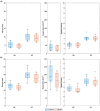Motor control enhancements by sub-threshold mechanical noise applied to foot soles during quiet standing
- PMID: 40646582
- PMCID: PMC12247419
- DOI: 10.1186/s12984-025-01697-7
Motor control enhancements by sub-threshold mechanical noise applied to foot soles during quiet standing
Abstract
Intervention to improve the balance ability of individuals with impaired balance is needed to prevent falls. While sub-threshold mechanical noise applied to foot soles has been shown to improve balance not only for balance-impaired but also healthy individuals, how calf muscle activity is changed to enhance motor control to achieve improvement has not been explored. To address this issue, we study the calf muscle activity of healthy young adults standing on firm and compliant surfaces, with and without noise applied to their feet. The compliant surface experiment simulates balance impairment. Center of pressure (COP) data was used to assess balance changes, surface electromyography (EMG) recorded muscle activity, and COP-EMG correlations measured muscle contribution to postural control. The Wilcoxon signed-rank test was used to compare the data between the control and noise conditions. On both surfaces, the applied noise enhanced motor control efficiency of all three calf muscle groups studied - the tibialis anterior (TA), lateral gastrocnemius lateralis (LG), and medial gastrocnemius (MG). Noise also increased the contribution of the LG muscle group to postural control in the anteroposterior direction. Our finding suggests that, for balance-impaired individuals with weak calf muscles, higher-frequency noise should be used - this will increase motor control efficiency, i.e., increase posture correction frequency with concomitant reduction in calf muscle contractions, which is well-suited to the weak muscles.
Keywords: Center of pressure (COP); Electromyography (EMG); Motor control; Postural control; Sub-threshold mechanical noise.
© 2025. The Author(s).
Conflict of interest statement
Declarations. Ethics approval and consent to participate: All methods used in this study were approved by the Monash University Human Research Ethics Committee (MUHREC) under project ID 14686. All study participants gave written, informed consent before the commencement of the experiments, and were allowed to decline further participation in the study at any stage of the procedure. Consent for publication: Not applicable. Competing interests: The authors declare no competing interests.
Figures







Similar articles
-
The effects of medial gastrocnemius muscle fatigue on regional modulation of the ankle plantarflexors during standing external perturbations.J Neurophysiol. 2025 Jul 1;134(1):382-396. doi: 10.1152/jn.00159.2025. Epub 2025 Jun 30. J Neurophysiol. 2025. PMID: 40588372
-
Associations Between Measures of Balance and Lower-Extremity Muscle Strength/Power in Healthy Individuals Across the Lifespan: A Systematic Review and Meta-Analysis.Sports Med. 2015 Dec;45(12):1671-92. doi: 10.1007/s40279-015-0390-z. Sports Med. 2015. PMID: 26412212 Free PMC article.
-
Physical exercise training interventions for children and young adults during and after treatment for childhood cancer.Cochrane Database Syst Rev. 2016 Mar 31;3(3):CD008796. doi: 10.1002/14651858.CD008796.pub3. Cochrane Database Syst Rev. 2016. PMID: 27030386 Free PMC article.
-
Evaluation of Sensory and Motor Function in Spinal and Bulbar Muscular Atrophy Using Quiet Stance and Reactive Postural Control.Neurol Int. 2025 May 22;17(6):79. doi: 10.3390/neurolint17060079. Neurol Int. 2025. PMID: 40559318 Free PMC article.
-
Muscle activity and postural sway during standing balance tasks in adults with hallux valgus reporting low levels of foot pain: A case-control study.Clin Biomech (Bristol). 2025 Aug;128:106629. doi: 10.1016/j.clinbiomech.2025.106629. Epub 2025 Jul 21. Clin Biomech (Bristol). 2025. PMID: 40706549
References
-
- Bagherzadeh Cham M, Mohseni-Bandpei MA, Bahramizadeh M, Forogh B, Kalbasi S, Biglarian A. Effects of vibro-medical insoles with and without vibrations on balance control in diabetic patients with mild-to-moderate peripheral neuropathy. J Biomech. 2020;103: 109656. 10.1016/j.jbiomech.2020.109656. - PubMed
-
- BERTEC Corporation: Force Plate FP4060-07-TM Product Details and Specifications. Technical Report 80P-0133, Bertec Corporation (August 2022)
-
- Borg F, Finell M, Hakala I, Herrala M. Analyzing gastrocnemius EMG-activity and sway data from quiet and perturbed standing. J Electromyogr Kinesiol. 2007;17(5):622–34. 10.1016/j.jelekin.2006.06.004. - PubMed
MeSH terms
LinkOut - more resources
Full Text Sources
Medical

